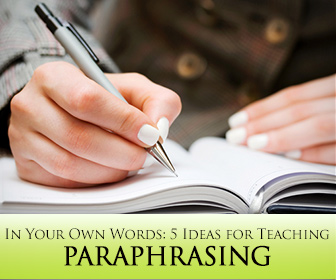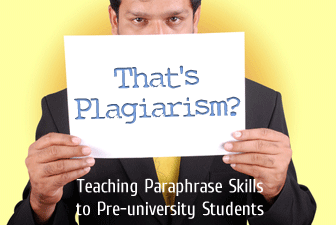In Your Own Words: 5 Ideas for Teaching Paraphrasing


Many EFL students want to attend a U.S. university; however, they lack the academic skills to write college level papers which involve research. Even if you teach students who don’t need to do academic research, paraphrasing and summarizing are beneficial tools for reading comprehension. Below are some ways to teach your students the valuable skill of paraphrasing.

As many countries don’t have intellectual copyright laws, many students don’t understand the concept of giving credit to an idea that didn’t come from them. Use concrete illustrations of “stealing” to help them see the connection. For example, you present the scenario that the students work together to make food at a restaurant. How would they feel if someone used their food without paying for it? Then move to more abstract notions, such as music and movies. How would they feel if someone used the songs which they wrote, and they never got any money for them? Finally, move to ideas and show them how stealing someone else’s’ idea is related to stealing someone’s work, even though there is no physical product that you can touch. Regardless if they agree or disagree that intellectual property deserves to be protected, explain that most universities feel this way and they can be in trouble if they don’t take plagiarism seriously.
Next, it’s important to explain that plagiarism can be both intentional and unintentional. Students can be punished similarly if they copy a paper from the Internet, copy a paper from another student, or use one or two ideas from a book and forget to cite them. Explain very clearly the consequences of what will happen if they get caught plagiarizing, for example, probation, failure, or even expulsion.
Students also should be aware how easy it is to get caught using information from the Internet. While many universities subscribe to sophisticated software which scans electronic documents, Google can be just as effective. Pretend that you wrote a paper and deliberately copy a sentence from a source online. Demonstrate to the students how you can type that one sentence using quotation marks in Google to find exactly where it came from.
Students need to see many models and examples of what you expect them to do and not do. An activity that works well is giving students a short original text and reading it out loud together. Spend a few minutes discussing the article so that you ensure comprehension. Have a word count at the bottom of the paragraph so students know how many words were in the paragraph. Prepare another short paragraph which changes some words and sentences from the original text but would still be considered plagiarism. Have them read it individually and circle any words/phrases which are used both in the original text and paraphrase, and add up the number of words repeated from the original text. If it is more than 15%, tell them that this is plagiarism and would receive a failing grade. It may work best for you to prepare these paragraphs so you can control how many words are copied from the original.
Next, show them an effective paraphrase of the text. Look at the paraphrase first and go through line by line to see how the author took the original sentences and transformed them into a paraphrase. Your ideal model should include the following ways of sentence transformation:
By looking at the specific sentences, students will have a concrete example of how to convey the same meaning by using their own words.
The following are practical steps for writing a good paraphrase:
Writing paraphrases together allows you to verbalize the thought process students need to transform the text. Start with individual sentences at first until students get the hang of it. An example dialogue between the teacher and the class could be as follows:
After students have practiced sentences, it may also be helpful to do a class paraphrase of a short paragraph as well. Nursery rhymes work very well for this, especially if students are familiar with these nursery rhymes. For example, paraphrases of Humpty Dumpty may look something like this:
After writing paraphrases as a class, allow them to work in pairs to paraphrase individual sentences and slowly work up to short paragraphs. Longer paragraphs are really unnecessary to paraphrase as summarizing would be a more effective and realistic skill for longer texts. Other good texts that work well for paraphrasing are nursery rhymes (especially ones they’re familiar with), famous quotations, and statistics. These will prepare students well for encountering quotes and facts in academic articles.
Another way to motivate students and practice paraphrasing is to play synonym games. Games like Taboo work well and encourage students to develop their vocabulary and expand their language to explain words in other ways. For advanced students, you can play a variation of Taboo with sentences. Each student is given a short sentence which they must get the class to guess. They must use synonyms and other phrases to get their team to recreate the original sentence.
Learning to paraphrase will help students to increase their reading comprehension and be better readers and writers while preparing them for academic situations.